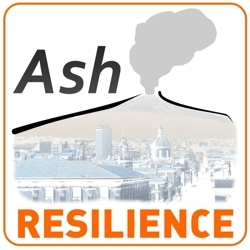Facilities and Expertise
The Ash-RESILIENCE project will benefit of the huge expertise and knowledge of INGV researchers acquired in more than 20-years long interdisciplinary work in eruption plume-monitoring, dispersal plume modelling, field data acquisition, laboratory measurements, and more recently, also ICT (Information and Communication Technologies). INGV expertise has been also consolidated through collaborations with several national and international partners (universities, research institutions, public offices, National Civil Protection Department), mostly in the framework of national and international projects.
Legend
- INGV-BO = Sezione di Bologna
- INGV-OE = Osservatorio Etneo, Sezione di Catania
- INGV-OV = Osservatorio Vesuviano, Sezione di Napoli
- INGV-PI = Sezione di Pisa
- INGV-RM1 = Sezione di Roma1
- INGV-RM2 = Sezione di Roma2
- ONT = Osservatorio Nazionale Terremoti
Topic |
Expertise |
Facility (analytical, computational, processing, laboratory, measuring, technical, … ) and/or Research Resource (software, …) |
Institutions in charge of specific facilities, installations and expertise or research infrastructures |
| Ground-based remote sensing | Measuring the source parameters of volcanic plumes | Doppler radar in L-Band (Voldorad2B) and S-Band (Vapour-S) at Etna | INGV-OE |
| - | - | Two AMPLE scanning lidars at Etna | INGV-OE |
| - | - | Doppler radars (Catania and Reggio Calabria airports) | Through a collaboration with DPC |
| Space-based remote sensing | Spatial technologies and datasets processing system | TIR multispectral radiometers (MODIS, SEVIRI, etc.) and GEO, LEO remote sensing datasets |
ONT INGV-OE |
| - | - | NOAA/NASA Suomi - NPP (National Polar - orbiting Partnership) and EUMETSAT/NOAA METOP-B | ONT |
| - | - | Balloon for atmospheric sounding (GliderSonde) | INGV-OE |
| - | SO2 observation from volcanic plume | Ultraviolet scanning spectrometer flame network and SO2 cameras | INGV-OE |
| - | Geophysical | Magnetic and electrical monitoring network | INGV-OE |
| Visual monitoring | Video-signal analysis | Permanent visible and thermal cameras | INGV-OE |
| Near field measurements | Field observations | High-speed imaging systems (visible and thermal cameras) | INGV-RM1 |
| - | - | Disdrometer systems | INGV-OE |
| Tephra sampling | - |
Field surveys Quantitative field analysis |
INGV-OE INGV-RM1 |
| Sample characterization | Textural and petrochemical analysis |
Scanning Electron Microscope (SEM) Stereo-microscope Petrographic microscope CAMSIZER® (Retsch) Image analysis tools |
INGV-OE INGV-PI INGV-RM1 |
| - | Magnetic analysis | MicroMag magnetometers | INGV-RM2 |
| - | Physical material property characterization |
Laboratory experiments Sedimentation models |
INGV-RM1 |
| Data Assimilation and Inversion | Remote sensing measurement analysis |
MACE (Multiplatform volcanic Ash Cloud Estimation) |
INGV-OE INGV-PI ONT |
| - | Satellite data system analysis |
Infrared Atmospheric Sounding Interferometer (IASI) Multi-angle Imaging SpectroRadiometer (MISR) Cloud-Aerosol Lidar and Infrared Pathfinder Satellite Observation (CALIPSO) Data assimilation techniques by integrating/using several codes and algorithms |
INGV-BO INGV-PI ONT |
| Procedure harmonization of volcanic ash clouds monitoring and forecasting | Probabilistic hazard assessment from tephra loading |
Expert elicitation Operational tools (BET_VH-Tephra@CF) |
INGV-BO INGV-OV INGV-OE |
| Numerical modelling | Tephra dispersal simulation | Fall3D, PUFF, VOL-CALPUFF, etc. |
INGV-BO INGV-OV INGV-OE INGV-PI |
| ICT tools | Data mining | HPC Resources and databases for volcanological data acquisition, modelling and processing (RDBMS, web services, web application, mobile applications and webGIS) | INGV-OE |
| - | Management of emergencies | TefraNet system | INGV-OE |
| - | Code development | Collaborative systems | INGV-OE |
| - | Development of Wireless Sensor Network (WSN) | Communication systems | INGV-OE |

